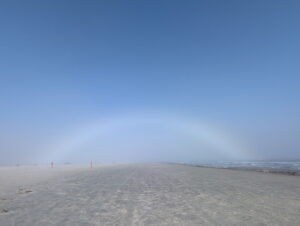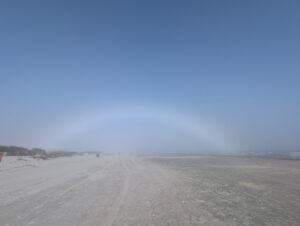
Galveston White Rainbow (January 2025 – K Carroll)
Recently a friend sent me photos she’d taken on a Galveston beach. The focal point was a white rainbow, shimmering in January’s late afternoon fog. Have you ever seen a white rainbow? I hadn’t. I’d never even heard of it.
Rainbows
We’ve all seen rainbows. Some of you might even remember the science of how a rainbow is formed. But if not, here’s a simple explanation.
A rainbow appears when sunlight, at the right angle, hits raindrops in the air. The droplets act as prisms, bending the white light and separating it into individual colors before reflecting them out of the drops and back to the ground.
Rainbows don’t have a physical location, and they can only be seen directly opposite the sun. No two people see the same rainbow because they don’t see it from the same perspective.
Did You Know…
- A rainbow is a circle not a semi-circle or arch. But it appears as such because the bottom half of the circle can’t be seen while standing at ground level. Only from far above can the full rainbow circle be seen.
- You can remember the order in which a rainbow’s colors appear by remembering ROY G BIV (red, orange, yellow, green, blue, indigo, violet).
Fogbows
A fogbow (also spelled fog bow) is a rare type of rainbow. It forms when sunlight, at the right angle, strikes the fog’s water droplets.
Without getting into a technical, scientific explanation, the main difference between a rainbow and a fogbow is the size of the water drops. Fog droplets—which are at least one hundred times smaller than typical raindrops—affect the light differently. Simply put, they still act as prisms, but to a lesser extent. Their small size scatters more than reflects the light. While all the colors are still there, they’re so weak the human eye isn’t usually able to see them. What is visible is a white haze created by the smearing or overlapping of the colors.
Can you see the hints of red and blue along this fogbow’s edges? (January 2025 – K Carroll)
Did You Know…
- Fogbows are rarer than rainbows.
- Fogbows are usually not as large as rainbows, but their shape is often wider.
- Fog water droplets are less than 20 micrometers, or about the width of one strand of human hair.
- Tinges of red or blue can occasionally be seen along a fogbow’s edges.
- Seen from above, a fogbow is called a cloud bow.
- Sailors often called fogbows sea-dogs.
- A fogbow that appears at night is called a lunar fogbow.
Legends and Myths
As you might imagine, the mysterious and eerie-looking fogbow has inspired myths and legends over time. (Though not as many as rainbows, since they aren’t as well known.) Their pale and ghostly look led some cultures to link them to spirits and the supernatural.
Did You Know…
- A fogbow is also called a white or ghost rainbow.
- Celtic mythology sees fogbows as bridges or portals, connecting the world of man with the world of gods and spirits.
- Scandinavian legends see fogbows as good luck. Spying one is said to bring success and wealth.
Finding a Fogbow
Like rainbows, fogbows are best seen early in the morning or late in the afternoon. Why? Because they can only occur when the sun is low in the sky. Areas that gather humidity—like fields, mountain valleys, ponds, lakes, or coasts—are the areas most likely to produce fogbows.
To see a fogbow, stand with the sun behind you and the fog bank in front of you. If you’re lucky, a fogbow, aka white or ghost rainbow, may appear.
Did You Know…
- To see a fogbow (or rainbow), the sun can never be more than 42° above the horizon.
- The thinner the fog bank, the better the chance of seeing a fogbow.
Final Thoughts

Galveston Fogbow (January 2025 – K Carroll)
Fogbows are more common in certain parts of the world. In the U.S. you can find them in the Pacific Northwest, especially along the coast; as well as California’s Redwood National and State Parks; Washington State’s Olympic National Park; and Alaska. Out of the country, try the Highlands of Scotland, Germany’s Black Forest, New Zealand’s South Island, and Iceland.
Now that you know what fogbows are, watch for them. If you see one, maybe it’ll bring you good luck.



I appreciate that I often learn something new from reading the latest dyk. Today was no exception. I have never heard of (or seen) a fogbow. The picture is great but now I want to see one with my own eyes. Maybe one day… thanks for yet another great ready Betty!
Thanks, Bryan. I’m glad you enjoyed this one. It was a learning experience for me, too. That’s one of the fun things about writing the DYKs, I almost always learn something new. And now that I know what a fogbow is, I’m going to be watching for my own.